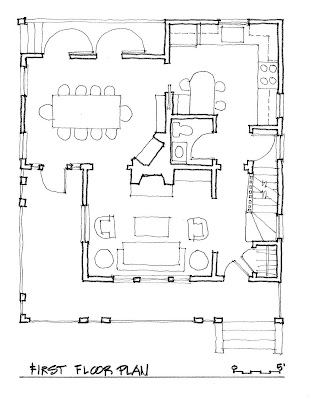New Houses in Historic Neighborhoods

What is it about historic
or traditional neighborhoods that makes us want to live in them? Is it their walk-ability or the scale and look
of its buildings?...the materials used or their architectural detail? Is it the
way they make us feel when we walk or drive around them, enjoying the way the
landscape and the buildings intermingle with each other? Might it be a
combination of all these factors? Walk-ability,
scale, durable materials, detail, good proportion, beauty, these are all terms
that help to define the character that we want to preserve whenever we declare
a neighborhood “historic”.
 |
| traditional house in Bayside |
In the USA, the Secretary of the Interior has issued Standards and Guidelines for the Restoration, Rehabilitation
and Preservation of Historic Properties. For this blog post we will only look
at the Standards for Rehabilitation. Rehabilitation is defined as: "the process of
returning a property to a state of utility, through repair or alteration, which
makes possible an efficient contemporary use while preserving those portions
and features of the property which are significant to its historic, architectural,
and cultural values." There are 10 standards for
Rehabilitation, standard no. 3 states: Each property shall be
recognized as a physical record of its time, place, and use. Changes that
create a false sense of historical development, such as adding conjectural
features or architectural elements from other buildings, shall not be
undertaken. Standard no. 9 states: New additions, exterior alterations, or
related new construction shall not destroy historic materials that characterize
the property. The new work shall be differentiated from the old and
shall be compatible with the massing, size, scale, and architectural features
to protect the historic integrity of the property and its environment.
 |
| traditional house in Bayside |
In my own neighborhood
of Bayside, New York, we have seen several new houses built that follow those guidelines.
Unfortunately their designs have, in fact, changed the character of the
neighborhood.
 |
| new house in Bayside |
 |
| new house in Bayside |
The
issue, as we see it, is that the meaning and nature of a “compatible” design is
so wide that, in the hands of less skillful designers, it can lead to chaos and
ugliness which in turn, can destroy the character of a beautiful neighborhood. In
our contemporary culture, the word “beautiful” has been banned from the academic
and professional lexicon for being perceived as a question of personal taste.
 |
| traditional house in Bayside |
There
was a time, in the not too distant past, when entire neighborhoods were
designed with houses coming straight out of architectural pattern books that
proposed certain styles such as: Colonial, Federal, Palladian, Victorian, Dutch
Colonial, and others. They all had a
number of architectural features that made them visually interesting such as
correctly proportioned columns, projecting bays, oriels, deep eaves, brackets,
stained glass and Palladian windows. These features were scaled in relation to
each other and to the building. They all used a common language of architecture
based on classical or traditional architecture and as such established a civic
“architectural conversation” among all the buildings in the neighborhood.
 |
| traditional house in Bayside |
That commonality of
architectural intention, of a civic architectural language, is absent
today. Architects instead resort to a
narcissistic architectural expression that either panders to their own or their
client’s desire for uniqueness over the urbanistic common good or is the result
of a lack of architectural design knowledge.
The new designs have a limited palette of architectural features and/or a
hodge-podge of un-coordinated or repetitive elements which are not scaled in relation to each
other or the building. These designs “look” traditional, but are far removed
from a living tradition.
 |
| new house in Bayside with repetitive elements |
 |
| new house in Bayside with uncoordinated and badly proportioned elements |
There are some who will state, as an excuse to
continue building these unfortunate designs, that our contemporary needs cannot
be accommodated using traditional architecture; that we have to use designs
that are “of our time”. We state that we
need to have the humility to imitate the good designs from the past and learn
from the ones that we have directly under our nose. We propose the following
designs to illustrate this idea. The first one is a hypothetical design for a
new house. The second one is a re-design of my house in Bayside.
 |
| new house design |
 |
| new house design first floor |
 |
| author's house in Bayside |
Unless designs for new houses in historic or
traditional neighborhoods start fitting into, instead of contrasting with the
existing architecture, our neighborhoods will deteriorate and lose their value.
















Thank you for sharing valuable knowledge about Design and Build in Islamabad,
ReplyDeleteDesign and Build in Islamabad
Nice post.Thanks for sharing this informative post. about the Architectural designer in Clapham ,
ReplyDeleteArchitectural designer in Clapham
Cool
ReplyDelete